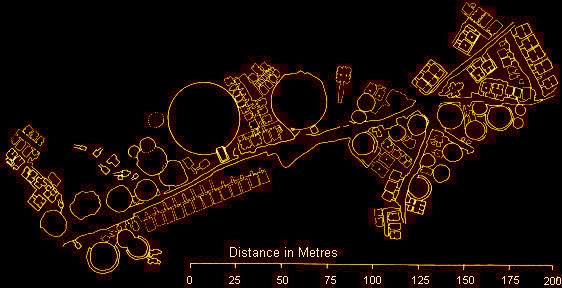 Map
of tombs
Map
of tombsInformation about Caere
The city of Caere (Etr. Caisra or Cisra) extends along a tufaceous plateau where the river Manganello meets the Fosso della Mola, a short distance from the sea. The presence of noticeable traces of protovillanovan settlements, particularly at Sasso di Fubara and Monte Abatone, testifies to the fact that this area was already densely populated in the prehistoric era. It is believed that the city was in the process of developing during the early Iron Age (9th century B.C.); this is borne out by the necropolis of Sorbo and of Cava della Pozzolana, which have given us numerous Villanovan burial sites
 Map
of tombs
Map
of tombs
whose form is less developed than that of those found in places in southern Etruria, such as Tarquinii, Veii and Vulci. The city's greatest period of prosperity, which is perhaps tied up with the intense exploitation of the mineral resources of the Tolfa Mountains and with the expansion of maritime trade, could already be clearly seen at the end of the 8th century B.C. It was then that Caere became the centre in which it is possible to recognize a whole series of crafts of great importance such as the outstanding production of Bucchero (typical Etruscan black pottery), of bronze and of italo-geometric ceramics. In the funeral rite, the Villanovan cremation was soon replaced by inhumation and the first chamber-tombs appear as early as the beginning of the 7th century B.C. These tombs testify to the high level of technical ability that the Etruscans had reached in the ancient orientally oriented age. These tombs imitate and therefore document the development of the architecture of civil dwellings, which were in turn an expression of the rising Etruscan aristocracy, and it is from them, in the best cases, that outstanding grave-goods have been brought to light.
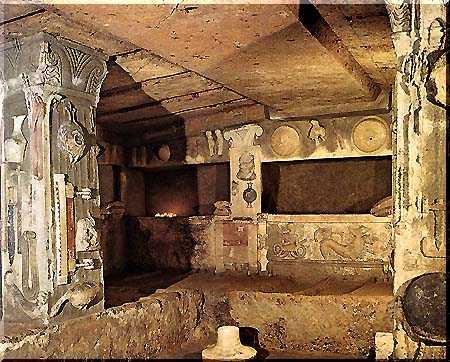 tomba
degli relievi bassi, Caere
tomba
degli relievi bassi, Caere
The Regolini-Galassi tomb, in the necropolis of Sorbo, is a noteworthy example: an unusual combination made by the adding to and joining of various surrounding burial places made it possible to discover intact, in 1863, the oldest burial place composed of an entrance way, outer room and a cell. In the central cell there was a buried corpse adorned with princely grave-goods of gold, silver, ivory, bronze and ceramics (now in the Vatican Museums), which can now be dated no later than 675 B.C. The great glory of Caere continued continued in the 6th and 5th centuries as well, when the city proved itself an important Mediterranean centre; together with the Carthaginians, the city fought, with uncertain outcome, against the Greeks of Phocaea in the Sardinian Sea, and Caere was the only Etruscan city to have a " thesauros" in the Sanctuary of Apollo at Delphi. The war nothwithstanding there were nevertheless strong cultural ties with the Greek world. This is documented not only by the numerous examples of pottery imported from Hellas, but above all by the influences on Etruscan art as can especially be seen in the painted ceramics (the workshop of the " Idrie Ceretane" set up at Caere by a craftsman who was perhaps Ionian) and in the clay modelling (e.g. the Sarcophagus of the Married Couple and the sarcophagus of the Lions, and architectural slabs in the British Museum).
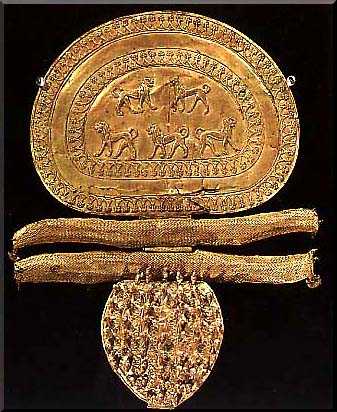 gold
fibula from a tomb in Caere
gold
fibula from a tomb in Caere
In this period, funereal architecture too illustrated the high level of well-being reached in the city. The tumuli in the necropolis of Banditaccia and Monte Abatone are of grand proportions, such as for example the " Tomb of the Greek Vases" and the " Tomb of the Shields and Chairs", and the attempt to give the cemetary areas a kind of urbanistic structure with straight streets and squares is worthy of note. Alongside the tumuli there appear, from the middle of the 6th century B.C., also cube-shaped or "dado" tombs which were socially connected with the upcoming middle classes and which have facades which imitate the appearance of city dwellings, with a room beneath.
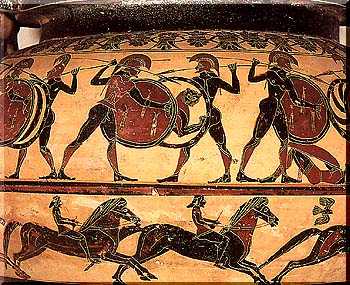 Caeretan
vase with war scenes
Caeretan
vase with war scenes
Between the 5th and 4th centuries B.C. Caere was hit by the general crisis of Southern Etruria, together with the decline in Etruscan naval power and the rapid strengthening of Rome. The abandonment of the city which began in the Hellenistic Age and gained momentum during the Imperial Age was complete by the time of the High Middle Ages.
Pyrgi
This was the principal port of Caere, identified in the area of Santa Severa where the excavations which were begun in 1957 have brought to light a sanctuary (probably dedicated to the divinity Ilicia-Leucothea) and which traditional sources say was destroyed in 348 B.C. by the tyrant of Syracuse, Dionysius.
Historically, Pyrgi followed the vents of the metropolis of Caere, with a period of great flourishing between the 7th and 5th centuries B.C., corresponding to the Etruscan dominion of the seas. From the 3rd century B.C., with the fall of Caere to the Romans, a maritime colony was set up there, definitively established in the 2nd century A.D. The sanctuary area is composed of two parallel temples ("A" and "B") and a sacred area. Temple "A" is of the traditional Etruscan style with three chambers. Among the remains of the clay decorations is a mythological frieze of outstanding importance. This frieze, which decorated the back facade, contains scenes of the myth of the "Seven Against Thebes" (now in the Villa Giulia Museum) and is a work in the severe style of the first decades of the 5th century B.C. Temple "B", which is older than temple "A", is similar to Greek structures with only one chamber surrounded by columns. It also has clay decorations and friezes adorning the central beam work and the mutuli of the facade with scenes of the "Feats of Heracles".
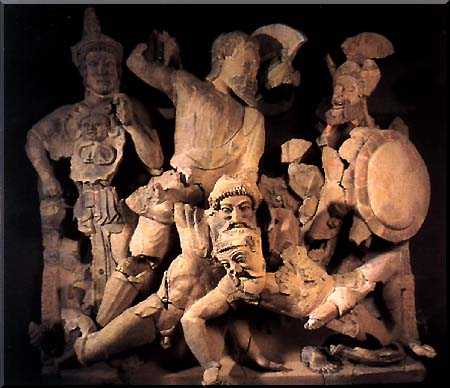 statues
temple "A" at Pyrgi
statues
temple "A" at Pyrgi
But the most sensational discovery from the Pyrgi excavations are undoubtedly the three golden sheets with bilingual inscriptions in Phoenician and Etruscan. These were found in a well between the two temples. Two of these are in Etruscan and one is in Phoenician as a translation, though literally exact. They refer to the dedication, made by the king (Etr. "lauchum") of Caere, Thefarie Velianas, to the relations between Caere and the Carthaginians who, as sources tell us, had already fought together against the Greeks of Phocaea at Alalia.
the golden plaques found between temples "A" and "B" at Pyrgi ; drawing to the right: the most left piece is the Phoenician text, the middle and right pieces are in Etruscan. Click on the drawings of the plaque and you will see the gold plaque again with a transcription and translation of the Etruscan text.